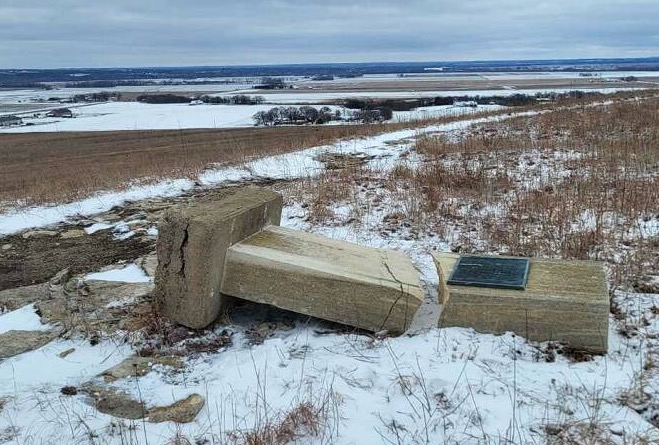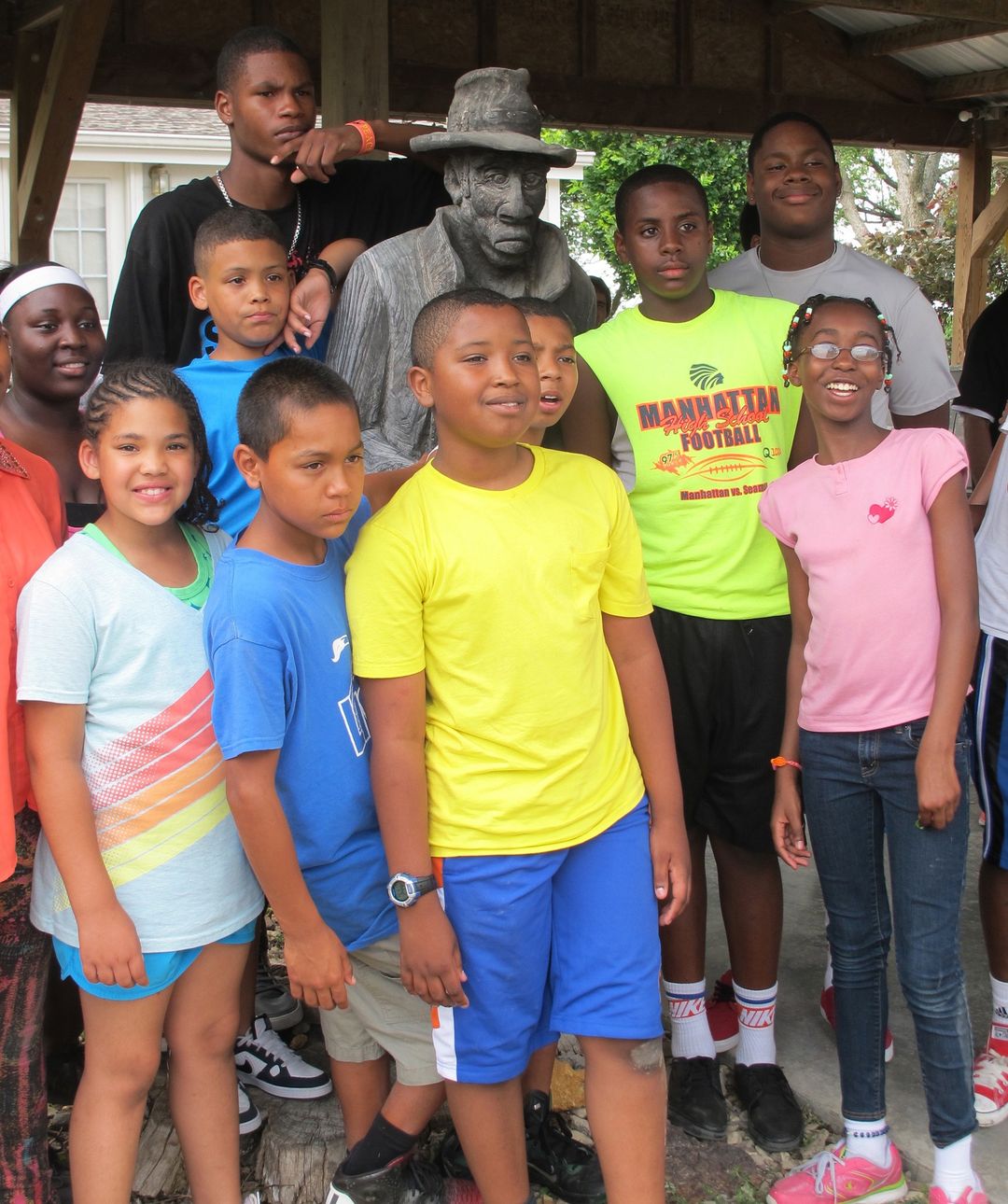THE UNDERGROUND RAILROAD
THE UNDERGROUND RAILROAD IN KANSAS

“In the 1830s, a frustrated slave hunter was said to have remarked that his slaves had disappeared into thin air somewhere near Newport, Indiana. The slave hunter, so the story goes, reckoned that his slaves must have taken a ride on some sort of railroad that ran underground. How else could he explain how quickly his runaways had disappeared—with the speed of a train—or how silently they had traveled—as if they were underground. The slave hunter was wrong, but the name stuck.
The “Underground Railroad” had no rails or train cars. It didn’t travel under the ground. Instead it was a network of people who worked together to hide and transport runaway slaves on their journey north to freedom.” Gwenyth Swain, President of the Underground Railroad.
It was neither underground nor a railroad, but was so called because its activities were conducted in secrecy and because railroad terms were used in the conduct of the system. It consisted of networks of “stations” kept by “conductors” or “station keepers” who provided food, shelter, and wagon transportation from one station to another along the line of travel to freedom. People were hidden in secret rooms, basements, attics, barns and other outbuildings. They were usually transported at night to avoid proslavery kidnappers.
This system of individuals and safe houses operated east of the Missouri River until Kansas and Nebraska Territories were created in 1854. The legislation was the result of a power struggle between pro and anti slavery forces in Congress. A compromise was reached, allowing residents in the new territory to vote whether Kansas would enter the Union as a free or slave state. The balance of power between North and South was at stake. This ushered in the period of our national history now called “Bleeding Kansas”.

When the predominately proslavery Supreme Court of the United States decided the Dred Scott case in 1857, they declared that the main law guaranteeing that slavery would not enter the new territories was unconstitutional. This fueled the struggle that resulted in the Civil War. After the Scott decision the Underground Railroad entered a new phase. Enslaved people, and even freed blacks, began seeking their freedom in Canada. It was at this point that the Kansas Underground Railroad became most active.
During these years before the Civil War, slaves seeking freedom from Arkansas, Missouri and Texas were routed through Eastern Kansas Territory.
In 1854, the only roads that existed in the territory ran between military outposts or were branches of the California/Oregon Road and the Santa Fe Trail. In the summer of 1856 Dr. Joseph Root and A. A. Jameson, members of the free state Kansas Central Committee, were appointed to lay out a road from Nebraska City, Nebraska Territory south to Topeka, a distance of about 80 miles. This was the Kansas portion of a trail that began in Iowa City, Iowa. Dr. Root was a member of the Connecticut Kansas Colony who had settled at Wabaunsee. He became a leader on the Free-State Committee when the original leaders were imprisoned.
The road was needed because proslavery forces in western Missouri had initiated a blockade that prevented free-state settlers from using the Missouri River to reach the territory. An overland route through Iowa, southeastern Nebraska and into Kansas was devised by the National Kansas Aid Committee to avoid the blockade.
When General James Lane led a large group of free-state settlers and young men inspired to save Kansas from slavery on the route it came to be known as the “Lane Trail”. The southern press called the group “Lane’s Army of the North” and portrayed them as rabble-rousers. The National Kansas Aid Committee had formed after proslavery forces sacked and burned Lawrence in May. At the time it was thought that unless free state advocates acted, Kansas would be lost to the South.

The territorial militia and federal troops, who were both proslavery, patrolled the main roads between Lawrence and Topeka. This situation made it necessary for larger and high profile “trains” to take a very circuitous route from Lawrence to southeastern Nebraska where they joined the main route of the Lane Trail that continued on to Iowa City. From there, more established escape routes were utilized through Illinois, Indiana, Ohio and Michigan, usually crossing into Canada from Detroit.
WESTERNMOST ROUTE OF THE UNDERGROUND RAILROAD

The westernmost route of the Lane Trail began at Lawrence and headed south to the Wakarusa River where “the fighting preacher” John E. Stewart ran a station with his wife.
From the Stewart’s, fugitives traveled west on the south side of the Wakarusa to Bloomington. From there they proceeded to Dr. Sabin’s cabin near Auburn. At that point they either went northwest to Mission Creek and Wabaunsee or southwest to the Harvey Settlement.
Activity on the Kansas Underground Railroad escalated in 1857 after the Dred Scott Decision and when the border war had subsided in the Kaw valley. Slaves escaping from Missouri, Arkansas and Texas were the primary “passengers”. The routes taken between safe houses fluctuated when participants came under suspicion or when a particular road was closely watched. Documentation exists indicating that stations at Auburn, Wakarusa, Lawrence and southern Lyon County fed stations in Wabaunsee County. After passing through Wabaunsee County, stations existed at Louisville, Manhattan, Juniata, and east of Centralia. Fugitives eventually met up with the main branch of the Lane Trail near the Nebraska border.
THE LANE TRAIL
After the sacking of Lawrence and the arrest and imprisonment of Free-State leaders at the end of May 1856, the Free-State cause was in danger of collapse. A national effort to organize aid for Kansas in the North was launched. ‘Kansas Committees’ were formed in thirteen states as well as a national coordinating group based in Chicago. Eli Thayer and other members of the New England Emigrant Aid Society were officers of the national committee.
James Lane, who was in Washington during the sacking of Lawrence, and other free-state leaders not arrested, spoke before rallies in Chicago, Detroit and other cities in the North. Lane’s performance in Chicago, before thousands of sympathizers, inspired contributions and enrollment in the cause. A vanguard group of seventy-eight free-state emigrants who signed up at the Chicago rally to go to the territory were turned back on June 20th by pro-slavery forces when they reached the border by steamboat via the Missouri.
This was the beginning of the blockade that forced free-state emigrants to take an overland route across Iowa, through the southeast corner of Nebraska to the northern Kansas border. Stating in early July, James Lane led an initial company of some 200 men across Iowa to Nebraska City, arriving there at the end of July. This is where the ‘trailblazing’ took place and where the terms “Lane’s Expedition”, Lane’s Party”, “Lane’s Army” and “Lane’s Trail” came into use in the press, and hence popular usage. The trail had not been laid out from the Nebraska/Kansas border to Topeka until Dr. J.P. Root, and A. A. Jameson, a committee of two sent by the Kansas Central Committee, accomplished the task in the first few weeks of July. Jameson’s brother, S.V. Jameson, had been appointed to the committee but apparently did not participate.
Meanwhile, more emigrant parties from Wisconsin, Illinois, Ohio and elsewhere totaling some 400 men women and children followed the route across Iowa ending up at Tabor, Iowa. Although bonafide settlers, they too were called “Lane’s Army”.
The leadership of the National Kansas Committee decided that Jim Lane had to be removed from his leadership position because he was perceived as a military man leading an armed insurgency into the territory. The Free-State position was to not engage Federal troops because this would be considered treason and very bad politically during free-state John Fremont’s bid for the presidency. Lane threatened to commit suicide but eventually agreed with the reasoning. Leadership of the company was given to Mr. Dickey of Lawrence. Lane entered the territory under an alias in a small group that included John Brown. After an amazing non-stop ride he entered Lawrence alone: everyone else had collapsed from exhaustion along the way.
Under the leadership of Dickey the rest of the company crossed into Kansas on the 7th of August. Groups split off to settle in Plymouth, Lexington, Holton and Topeka.
There are many first person accounts of the trip from Tabor and Nebraska City into Kansas.
As Shalor Eldridge wrote;
“For material regarding the make-up of these companies, the names of conductors, points of organization, etc., see Kansas Historical Collections, vol. 8, p. 308, 309 text and footnote. While some things have been written about the party to come through Iowa to Kansas, known as ‘Lane’s army of the North,’ no general story has yet been told.
There is abundant material to be found on the subject. The letters of Hyatt and others connected with the National Kansas Committee; the Webb scrapbooks; the executive minutes of Gov. John W. Geary, published in Kansas Historical Collections, vol. 4; scattering stories of different members of this emigration movement published in various volumes of the Historical Collections and in the Andreas History of Kansas, all form primary and secondary sources from which a valuable paper on this little-known phase of Kansas history could be compiled.”
– Shalor Eldridge, Early Days In Kansas.
HARVEYVILLE
In territorial days this community was known as the Dragoon or Harvey Settlement. It was located in the extreme southeast corner of the county, near the borders of Shawnee, Osage and Lyon counties. Council City (Burlingame), part of Shawnee County in territorial times, is 8 miles to the southeast. The main route of the Santa Fe Trail passed through the county several miles south of Harveyville.
This community began in May of 1854, only weeks after passage of the legislation that created the territory. George M. Harvey took the first claim here, which is credited as being the first in Richardson County. He was also the first Quaker to settle in the territory. The Quakers had been one of the first groups to oppose slavery and many families were involved in the Underground Railroad. Within a few months his brother Samuel and his parents Henry and Ann Harvey and other family members (Madden, Akin) arrived, making their own claims.
The Harvey family had been involved with the anti-slavery movement and the Underground Railroad when they lived in Ohio. Their Kansas log house soon became a refuge for slaves seeking freedom in Canada. Their farm is now a registered Network to Freedom site. The existing house was built around 1900, most likely near the site of the Harvey cabin. Charles Leonhardt, author of the manuscript, The Last Train, an account of a June 1860 trip, noted that the Harvey home was a station used for special situations when extreme caution was required. Its out of the way location was an advantage. Stephen Spear, who arrived in the fall of 1857, writes in his history of the settlement that after hiding in the Harvey cabin, fugitive slaves were taken by wagon at night to the farm of Enoch Platt near Wabaunsee.
Spear’s brother, Daniel also spoke about the UGRR in the community. At a gathering of the Old Settlers Association in 1899, he said that Jehu Hodgson was the local conductor of the railroad. Jehu and Mary Loy Hodgson’s son Frank wrote a colorful account of his parent’s UGRR activity titled “Charlie the Slave”. He relates that on one occasion the Harvey cabin was under suspicion, so the Hodgson’s were caring for a slave named Charlie until the time was right to move him north. One day a neighbor came calling after breakfast. “The caller was a stayer and did not go until nearly noon.” The family sat nervously, expecting their ruse would be discovered. It was not, and Frank tells how his father eventually hid Charlie and a woman and her five children in a wagon disguised as a load of corn. He took them north through Topeka and on to a station near Leavenworth.
The Harveyville Cemetery contains the graves of Underground Railroad participants Ann Harvey, Jehu and Mary Hodgson (Thomas), and Morris Walton. Morris Walton drove the team of horses loaned by Dr. Sabin in Leonhardt’s account of The Last Train.
MISSION CREEK

Free state advocates settled the Mission Creek Settlement, now called Keene, in 1855. Its numbers were increased in the fall of 1856 when a party from Wisconsin arrived with “Lane’s Army of the North”. Among them was the Ross family, including Senator Edmund G. Ross, who is featured in President John F. Kennedy’s book Profiles in Courage.
Stories passed down in the William and Elizabeth Beach family places one of the Mission Creek stations on the face of the bluff south of the creek on the Beach property. Beach descendants continue to own the property. The Kansas Farm Bureau has declared this farm to be the state’s oldest that is still owned and operated by the original family. The station here was probably a crude shelter in the woods. The Beach log cabin was located a short distance west, on property now owned by a neighbor. Although they each had their own claims, the household consisted of William and Elizabeth and William’s son, Dr. Samuel E. Beach and his wife Jane McGregor Beach. The log cabin had a dirt floor and was so small that cooking had to be done outdoors.
William Beach died in Wisconsin and is buried there. His wife Elizabeth is buried in the Mission Creek Cemetery (Keene) overlooking the site where 150 years ago she helped those seeking freedom. William’s son, Dr. Samuel E. Beach enlisted in the 8th Regiment, Kansas Volunteer Infantry as 1st assistant surgeon. He was taken prisoner while in charge of the wounded at Chickamauga. He died there of disease Nov. 4th 1863. A letter from O.W. Little to Wilbur Siebert, the well-known Underground Railroad researcher, in the Siebert papers at the Ohio Historical Society, gives further information about the UGRR in this neighborhood. Little says that George Ross, brother of Senator Edmund G. Ross, sheltered slaves that had probably come from the Auburn station, as did Harvey Loomis and Dr. Beach. He says that Ettie Beach Snyder remembers hearing a story “telling of two valuable slaves who were brought to their home from Auburn, one being kept at their place all winter, the other at the Loomis place. A letter was received from one of them after they got to Canada.”
Fugitives traveling from Auburn or Mission Creek to the Wabaunsee settlement probably crossed Mill Creek either at Waterman’s crossing south of present Maple Hill, or at a crossing just east of the bridge on Snokomo Road. From here the route, including that of Leonhardt’s Last Train, headed northwest where it joined the military road that ran between Topeka and Fort Riley. John Fremont was the first to record this route in 1843. Ruts from the trail can still be seen in the Bolton Wildlife Preserve and in pastures along the route. As the trail descends into the Kaw valley it crossed the eastern side of Mount Mitchell and past the cabins of Joshua Smith and Captain William Mitchell.
WABAUNSEE
One of the first families to settle in this area after the territory was created was that of James and Hannah Bisby and their four children. They had come from Pavilion, New York with the fourth New England Emigrant Aid Company in the fall of 1854. Most of this party settled in the Manhattan vicinity. Wabaunsee is about 15 miles southeast of Manhattan. The Bisbys soon built a comfortable home and extended their hospitality to newly arrived emigrants and later to enslaved people seeking their freedom.
James Bisby is credited with suggesting the name Wabaunsee for the town site that Peter Sharai had established in 1855 two miles north and one mile west of the Bisby home. It was on the south bank of the Kaw River several miles west of the Potawatomi Reservation. The Potawatomi homeland had been in the southern Great Lakes region and they had been forcibly moved to Indian Territory in the 1830s and 40s. Wabaunsee was a chief who had represented the tribe in treaty negotiations. He died before the tribe was moved to Kansas from western Iowa.
A post office called “Wabonsa” was established in December of 1855. In April of 1856, the famous group of free state emigrants organized in New Haven, Connecticut known as the Connecticut Kansas Colony chose to settle in the Wabaunsee area. The congregation of Henry Ward Beecher’s Plymouth Church in Brooklyn, New York raised $625 to help arm the group to protect itself from proslavery border ruffians. Another member of his congregation donated Bibles and hymnbooks. Soliciting arms from the pulpit of a church and arming free state emigrants with superior weaponry created quite a controversy, and the press at the time began calling the colony “Beecher’s Rifle Colony”. This evolved into calling a Sharps rifle a “Beecher’s Bible”.
The First Church of Christ at Wabaunsee was built by this community in 1861. It’s now called the Beecher Bible and Rifle Church and is listed on the National Register of Historic Places.
Its mission accomplished, the colony soon disbanded, merging with the earlier settlers to form the Wabaunsee Town Company. Soon after the colony arrived they formed a Militia called the Wabaunsee Prairie Guards, which was called up to help defend Lawrence when Colonel Buford’s South Carolina troops were threatening to destroy the town. They manned breastworks on Mount Oread for six weeks and fought alongside James Lane and John Brown in a number of skirmishes.
Most accounts indicate that the Underground Railroad began running through Wabaunsee in 1857, after settlers had established adequate shelter for themselves and the border war had quieted down. Those known to have been involved were: J. M. and Hannah Bisby, Julius Willard, Austin and Maria Kelsey, Enoch and Sarah Platt, J. Evarts Platt, Charles and Maria Lines, Joshua and Mary Smith, John Smith, Samuel Weed, Amos A. Cottrell, Captain William Mitchell and his sister Agnes Mitchell.
The only original structure from this period still existing is the log cabin built by Captain William Mitchell in 1856. Today it is a private residence on the Mitchell farmstead across the road from Mount Mitchell. The attic of this log cabin served as a hiding place for freedom seekers (a second story was added later). One account relates that when it was safe, Mitchell would take the fugitives down the road to Joshua Smith‘s house, and his son John would take them across the river, probably at the “riffles” east of St. George. In another story, told to Mitchell’s son Will by his Aunt Agnes, “She told of their concealing eight run-away slaves in the attic of their cabin for a number of days, until they could be safely moved by father and a neighbor, Enoch Platt, to the next underground station of their escape route north.”
The Mitchell log cabin remains as the living room of the house that grew around it. Its log floor joists, some with the bark still intact, can be seen in the cellar. A small plexi-glass window in the living room reveals the log walls and recently the logs on the south side of the cabin have been exposed in an enclosed porch.
After crossing the Kansas River “trains” either went through Manhattan and Juniata (Rocky Ford) or through Louisville, and on into Nemaha County sixteen miles east of Centralia. The route then joined the main branch of the Lane Trail and continued on to Falls City, and Nebraska City then across the Missouri River to Tabor, Iowa. At Iowa City, the eastern end of the Lane Trail, those seeking their freedom made their way through Illinois, Indiana and Ohio, on more established routes, eventually crossing into Canada at Detroit.
The Park is open year round, dawn to dusk. Removal of plants and animals from the Park is strictly forbidden.























Recent Comments